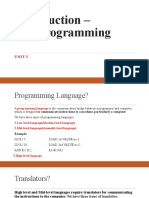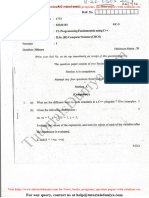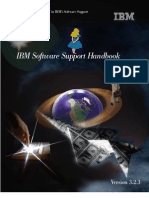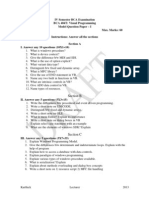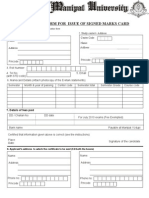BIT C 1
BIT C 1
Uploaded by
Razza YadavCopyright:
Available Formats
BIT C 1
BIT C 1
Uploaded by
Razza YadavOriginal Description:
Original Title
Copyright
Available Formats
Share this document
Did you find this document useful?
Is this content inappropriate?
Copyright:
Available Formats
BIT C 1
BIT C 1
Uploaded by
Razza YadavCopyright:
Available Formats
1 C Programming BIT
Unit 1
Introduction
Problem Solving
Problem Solving is a systematic approach to find and implement the solution to a problem.
The computer is the symbol manipulating machine that follows the set of instructions called
program.
Program
A set of instructions to solve the problem or the specification of the sequence of
computational steps in a particular programming language is called program. The task of
developing program is called programming.
Problem Solving Techniques involve the following steps
1. Problem Definition
- To solve a problem, the first step is to identify and define the problem.
- The problem must be stated clearly, accurately and precisely.
2. Problem Analysis
The problem analysis helps in designing and coding for that particular problem.
- Input specifications: The number of inputs and what forms the input are available
- Output specifications: The number of outputs and what forms the output should be
displayed.
3. Designing a program
Formulate an algorithm and flowchart to solve the problem.
- Algorithm: step by step procedure of solving a problem
- Flowcharts: It is the graphical representation of the algorithm.
4. Coding
Writing instructions in a particular programming language to solve a problem. The
compiler will convert the program code to the machine language which the computer can
understand.
5. Program testing
After writing a program, programmer needs to test the program for completeness,
correctness, reliability and maintainability. There are different types of tests:
- Unit testing
- Program Testing
- Verification Testing
- Validation Testing etc.
6. Installation and Maintenance
- Installation of a computer program is the act of making the program ready for execution.
- Maintenance means periodic review of the programs and modifications based on user
requirements.
https://collegenote.pythonanywhere.com/ College Note
2 C Programming BIT
Algoithm
An algorithm is a step by step descriptions of the procedure written in human understandable
language for solving given problem.
The characteristics of an algorithm are:
- Algorithm must have finite number of steps.
- An algorithm should be simple.
- An algorithm must take at least one or more input values.
- An algorithm must provide at least one or more output values.
Advantages of Algorithms:
- An algorithms are very easy to understand.
- Algorithm is programming language independent.
- Algorithm makes the problem simple, clear, correct.
E.g.
Algorithm to find largest number among three numbers:
step 1: start
step 2: input a,b,c
Step 3: if (a>b) and (a>c) then print “a is greater”.
Else if (b>a) and (b>c) then print “b is greater”.
Else print “c is greater”.
Step 4: stop
Algorithm to find sum and average of first 𝒏 natural numbers:
1. Start
2. n = input an integers
3. sum = 1 + 2 + 3 + ⋯ … … + 𝑛
4. avg = sum/n
5. print sum, avg
6. stop
Algorithm to find simple intersest:
1. Start
2. Input 𝑝, 𝑡, 𝑟
3. Calculate 𝐼 = 𝑝 ∗ 𝑡 ∗ 𝑟/100
4. Print 𝐼
5. END
Algorithm to find sum of two numbers:
1. Start
2. Input two numbers 𝑛1 𝑎𝑛𝑑 𝑛2
3. Calculate 𝑠𝑢𝑚 = 𝑛1 + 𝑛2
4. Print 𝑠𝑢𝑚
5. END
https://collegenote.pythonanywhere.com/ College Note
3 C Programming BIT
Flowchart
- A flow chart is a step by step diagrammatic representation of the logic paths to solve a
given problem.
- A flowchart is graphical representation of an algorithm.
Advantages :
- The flowchart shows the logic of a problem displayed in pictorial fashion.
- It is useful for debugging and testing of programs.
- Program could be coded efficiently using flowcharts.
- The Flowchart is good means of communication to other users.
Disadvantages:
- It is not useful to represent complex program logic
- For any alterations, the flowcharts have to be redrawn completely.
Rules for writing flowcharts :
- The flow chart should be clear, neat and easy to follow.
- It should be drawn from top to bottom.
- A flowchart always begins with start symbol and ends with stop symbol.
- Flow lines are used to join the symbols
- Decision box should have one entry point and two exit points.
- For lengthy flowcharts, connectors are used to join them.
Symbols used in flowcharts:
https://collegenote.pythonanywhere.com/ College Note
4 C Programming BIT
E.g.
Flowchart to compute simple interest:
Flow chart to print the sum of five numbers:
https://collegenote.pythonanywhere.com/ College Note
5 C Programming BIT
Q. Write an algorithm and draw flowchart to test a number for even or odd.
Soln:
Algorithm:
1. Start
2. Input a number which is to be tested for even or odd.
3. If 𝑛𝑢𝑚𝑏𝑒𝑟 % 2 == 0 then print “The number is even”.
Else print “The number is odd”.
4. End
Flowchart:
Q. Write an algorithm and flowchart to find out whether a given integer is zero,
positive, or negative.
Soln:
Algorithm:
1. Start
2. Print”Enter a number”.
3. Read 𝑛
4. If 𝑛 > 0 then print “The number is positive”
Else if 𝑛 < 0 print “The number is negative”
Else “The number is zero”.
5. Stop
https://collegenote.pythonanywhere.com/ College Note
6 C Programming BIT
Flowchart:
Q. Write an algorithm and flow chart for finding largest of three numbers.
Soln:
Algorithm:
1. Start
2. Input A,B,C
3. If (A>B) and (A>C) then print “A is greater”.
Else if (B>A) and (B>C) then print “B is greater”.
Else print “C is greater”.
4. Stop
Flowchart:
https://collegenote.pythonanywhere.com/ College Note
7 C Programming BIT
Q. Write the algorithm for obtaining the final grade of student based on mark and draw the
flow chart.
Soln:
Algorithhm:
1. START
2. Input marks of students
3. If marks >= 90
Print “Grade = A”
else if marks >= 80
Print “Grade = B”
else if marks >= 70
Print “Grade = C”
else if marks >= 60
Print “Grade = D”
else
Print “Grade = E”
4. END
Flowchart:
https://collegenote.pythonanywhere.com/ College Note
8 C Programming BIT
Program Development Cycle
Coding
Coding is the translation of an algorithm or flowchart into a suitable computer language like
c, c++, java etc. Coding is the real job of programmer. The algorithm to solve a problem
which is described by pseudo-code or flow chart is converted into actual programming
language code. The code written by programmer by using any programming language like C,
C++ etc. is called the source code or source program.
Compilation and Execution
The source code written in any programming language is not directly executed by the
computer. It should be translated into to the machine readable format i.e. actual machine
language. The process of translation of source code into the target code is called the
compilation. Each programming language has its own compiler program that translates the
source code into its target code. The converted program in actual machine language is then
executed by the computer which is known as program execution.
https://collegenote.pythonanywhere.com/ College Note
9 C Programming BIT
Debugging and Testing
A written program may have errors, some errors can be detected by the language compilers
and some errors cannot be identified by the compiler and occurred during the program run.
Common types of errors are:
Syntax Errors: Identified by compiler at the program compilation time.
Logical Errors: Not identified by the compiler at compile time and identified at the execution
time. E.g. misuse of operators
So testing is the process of checking the program for its correct functionality by executing the
program with some input data set and observing the output of the program.
Documentation
From the start of the problem solving to the end of the implementation of the program, all the
tasks should be documented i.e. kept for future reference. It is also the important part of the
problem solving or program development. Documentation may be of two types:
a. Technical Documentation known as programmer's documentations which includes the
problem analysis to implementation details for that program. It is needed for future reference
for any modification, update of the program.
b. User manual is the documentation prepared for the end-user of the program that guides the
user how to operate the program.
Introduction to C
C programming,
- Was developed by Dennis Ritchie at AT&T Bell Labs, USA in 1972.
- Is a high-level programming language used to develop applications for high-level
business and low-level system programs.
- Became popular because of its power, simplicity and ease of use.
- Enables system program writing, using pointers.
- It is reliable, simple and easy to use.
Features of C:
- Robust language, which can be used to write any complex program.
- Has rich set of built-in functions and operators.
- Well-suited for writing both system software and business applications.
- Efficient and faster in execution.
- Highly portable.
- Well-suited for structured programming.
- Dynamic memory allocation.
History of C
C language has evolved from three different structured language ALGOL, BCPL and B
language. It uses many concepts from these languages and introduced many new concepts
such as data types, struct, pointer.
https://collegenote.pythonanywhere.com/ College Note
10 C Programming BIT
Structure of C Program
https://collegenote.pythonanywhere.com/ College Note
11 C Programming BIT
1. Documentation Section
The documentation section is the part of the program where the programmer gives the
details associated with the program. He usually gives the name of the program, the
details of the author and other details like the time of coding and description. It gives
anyone reading the code the overview of the code.
E.g.
/*
C programming basics & structure of C programs
Author: Jayanta Poudel
Date : 28/09/2019
Update:29/09/2020
*/
2. Link Section
The link section provides instructions to the compiler to link functions from the
system library such as using the include directive.
E.g. #include<stdio.h>
stdio.h is an input output header file which contains the input/output and file handling
functions which are used in C programs. The required header file should be included
using #include preprocessor directive.
3. Definition Section
The definition section defines all symbolic constants such using the #define
directive.
E.g. #define PI 3.14
4. Global Declaration Section
There are some variables that are used in more than one function. Such variables
are called global variables and are declared in the global declaration section that
is outside of all the functions. This section als o declares all the user-defined
functions.
E.g. int a=10;
int sum(int, int);
5. Main() function Section
Every C-programs needs to have the main function. Each main function contains 2 parts.
Declaration part: The declaration part declares all the variables used in the
executable part.
Executable part: There is at least one statement in the executable part. These two
parts must appear between the opening and closing braces. The program
execution begins at the opening brace and ends at the closing brace. The closing
brace of the main function is the logical end of the program.
E.g.
int main( )
{
int a=10;
printf(“%d”, a);
return 0;
}
https://collegenote.pythonanywhere.com/ College Note
12 C Programming BIT
6. Subprogram Section
User can define their own functions in this section which perform particular task
as per the user requirement. So user create this according their needs.
E.g.
int sum(int a, int b)
{
return a+b;
}
Simple C program
/* C-program to display “Hello, World” */
#include <stdio.h>
int main()
{
printf("Hello, World!");
return 0;
}
Output:
Hello, World!
printf( ):
printf is an output function which has been defined in stdio.h file. Whatever is put inside the
function printf between two double quotes is printed on the screen.
Program to add two integers
#include <stdio.h>
int main()
{
int number1, number2, sum;
printf("Enter two integers: ");
scanf("%d %d", &number1, &number2);
// calculating sum
sum = number1 + number2;
printf("%d + %d = %d", number1, number2, sum);
return 0;
}
https://collegenote.pythonanywhere.com/ College Note
13 C Programming BIT
Output:
Enter two integers: 12
11
12 + 11 = 23
The scanf( ) function:
Scanf() is an input function defined in stdio.h header file. Scanf accepts the input from
keyboard.
The & is an address operator in scanf function . &variablename specifies the memory
address for the variable and the value entered from keyboard is stored in that specified
location.
For more notes visit:
https://collegenote.pythonanywhere.com/
https://collegenote.pythonanywhere.com/ College Note
You might also like
- IBM 4690 Programming GuideDocument476 pagesIBM 4690 Programming Guideapokalipxys100% (2)
- 3 - Lectures Note Week4Document39 pages3 - Lectures Note Week4eaina6933No ratings yet
- Unit-2Document13 pagesUnit-2subhrakantabaral04No ratings yet
- SCSA1104 Unit 1Document25 pagesSCSA1104 Unit 1G.AkshayaNo ratings yet
- Python Programming NotesDocument92 pagesPython Programming NotesSREEJITH S NAIRNo ratings yet
- Unit I - Part 2Document26 pagesUnit I - Part 2Danish JasonNo ratings yet
- Assignment 1-Phi HùngDocument46 pagesAssignment 1-Phi HùnghoangvuNo ratings yet
- UNIT-2Document24 pagesUNIT-2mkdoesrandomshitNo ratings yet
- C Programming Part 2Document10 pagesC Programming Part 2molocof324No ratings yet
- Cat1 CDocument84 pagesCat1 Cchinnureddyseelam07No ratings yet
- 4th Sem Bcom May 19Document10 pages4th Sem Bcom May 19skNo ratings yet
- Module - 1 - Q&aDocument13 pagesModule - 1 - Q&aSamuel JohnpeterNo ratings yet
- Chapter 1Document42 pagesChapter 1eshetuNo ratings yet
- Introduction To Algorithms and FlowchartDocument48 pagesIntroduction To Algorithms and FlowchartAbdullah Al-suleimaniNo ratings yet
- Unit 1 GE3151 PSPPDocument37 pagesUnit 1 GE3151 PSPPrajeshwarisNo ratings yet
- DD CP Chapter2Document36 pagesDD CP Chapter2Harshaa VNo ratings yet
- Algorithm and Flowchart NotesDocument5 pagesAlgorithm and Flowchart Notesfasnabasheer911No ratings yet
- Updated Section 2 (1)Document36 pagesUpdated Section 2 (1)niloyahmedrasel24No ratings yet
- Flowchart AlgorithmDocument13 pagesFlowchart AlgorithmSrija ReddyNo ratings yet
- CPDS UNIT I FinalDocument110 pagesCPDS UNIT I FinalsivsaiNo ratings yet
- C Programming (Assignment) !Document8 pagesC Programming (Assignment) !rishavkhadka43No ratings yet
- Note 1438938683Document38 pagesNote 1438938683Siva GaneshNo ratings yet
- Share Dorig - Princess - Ashlie COMPUTER PRIGRAMMING LESSON TWODocument13 pagesShare Dorig - Princess - Ashlie COMPUTER PRIGRAMMING LESSON TWOJosua J. MangilaNo ratings yet
- Unit I Notes-C ProgDocument68 pagesUnit I Notes-C Proghaseenasajeeb9633No ratings yet
- PST Book - Unit 1 - 5Document192 pagesPST Book - Unit 1 - 5Saipriya VempalliNo ratings yet
- Planning of Computer Programming-In Today Word ADocument16 pagesPlanning of Computer Programming-In Today Word AKunal DasNo ratings yet
- Computer Programming: Chapter 2. Problem Solving Using ComputerDocument14 pagesComputer Programming: Chapter 2. Problem Solving Using ComputerrajadNo ratings yet
- C Language Chapter 1Document4 pagesC Language Chapter 1Ekta SinghNo ratings yet
- Chapter 1Document41 pagesChapter 1abebemako302No ratings yet
- GE8151 Notes PSPPDocument100 pagesGE8151 Notes PSPPaswinNo ratings yet
- Problem Solving TecDocument5 pagesProblem Solving Tecpaiprashanth92No ratings yet
- I PUC Unit BDocument22 pagesI PUC Unit BAman kekkarNo ratings yet
- Pps NotesDocument204 pagesPps Notes5377696raghav10No ratings yet
- C Programming - Unit 1 FinalDocument72 pagesC Programming - Unit 1 FinalKartik RaghuwanshiNo ratings yet
- AST 103 Programming With C/C++ Lecture-02: Process of Writing A ProgramDocument21 pagesAST 103 Programming With C/C++ Lecture-02: Process of Writing A ProgramTarikulNo ratings yet
- Introduction To Algorithms: Unit 1 / Chapter 1Document34 pagesIntroduction To Algorithms: Unit 1 / Chapter 1Mamatha NUNo ratings yet
- PPS Unit 1Document132 pagesPPS Unit 1eekshith369No ratings yet
- Unit 1 PSPPDocument27 pagesUnit 1 PSPPkarthibalakrishnan29No ratings yet
- Unit 2Document23 pagesUnit 2Niranjan TamangNo ratings yet
- Introduction To Computer ProgrammingDocument8 pagesIntroduction To Computer Programmingmhil06No ratings yet
- UNIT 1 - Program Logic DevelopmentDocument36 pagesUNIT 1 - Program Logic DevelopmentDwaranath SrinivasanNo ratings yet
- GE8151 PROBLEM SOLVING AND PYTHON PROGRAMMING Unit 1Document40 pagesGE8151 PROBLEM SOLVING AND PYTHON PROGRAMMING Unit 1lavanya2webNo ratings yet
- 01 ES26 Lab - Intro To ProgrammingDocument28 pages01 ES26 Lab - Intro To ProgrammingWilmarcNo ratings yet
- ITskills Unit 1Document8 pagesITskills Unit 1Bhagya RNo ratings yet
- Chapter 6 Grade 12Document10 pagesChapter 6 Grade 12dawit tadewoseNo ratings yet
- CSC 121. Problem Solving Lesson 3Document21 pagesCSC 121. Problem Solving Lesson 3adejobiolajide04No ratings yet
- Unit 1 Prog Logic DevelopmentDocument8 pagesUnit 1 Prog Logic DevelopmentAtharv KhadatareNo ratings yet
- Computer Programming ReviewerDocument18 pagesComputer Programming ReviewerWhiskeryFrogNo ratings yet
- PDF_Maker_1734379673925Document35 pagesPDF_Maker_1734379673925kaayyokaayyamosupperusuunsaNo ratings yet
- Chapter_4Document12 pagesChapter_47t50ramcharvithreddymudumalaNo ratings yet
- APznzaan_OyAH4nnNVM2ehVv11_rq5yt5KN4a5Pt8b2fCa-j-a-nLaL-P9ZzvwTI0HQa36mBDm8gt6ugh9j00BqR5MMI0d74wUgNrHvqCfSepprS4CG0MXWagHXYttdmtmSXgstn4KsFIRYU-t9iKMSWinHVp8jByKasCmPBCwU4kkzUL890EfgJjDJLrWa7qkyfKAbBYiLhDocument32 pagesAPznzaan_OyAH4nnNVM2ehVv11_rq5yt5KN4a5Pt8b2fCa-j-a-nLaL-P9ZzvwTI0HQa36mBDm8gt6ugh9j00BqR5MMI0d74wUgNrHvqCfSepprS4CG0MXWagHXYttdmtmSXgstn4KsFIRYU-t9iKMSWinHVp8jByKasCmPBCwU4kkzUL890EfgJjDJLrWa7qkyfKAbBYiLhasowadnoorNo ratings yet
- CP FinalDocument165 pagesCP FinalVikki KotaNo ratings yet
- Algorithm: Algorithm Is A Step-By-Step Procedure or Sequence of Instruction To Solve A ProblemDocument38 pagesAlgorithm: Algorithm Is A Step-By-Step Procedure or Sequence of Instruction To Solve A Problemsiva ganeshNo ratings yet
- Unit 1Document125 pagesUnit 1reddyabyuNo ratings yet
- 2 Chapter 2 - Algorithmic Problem SolvingDocument27 pages2 Chapter 2 - Algorithmic Problem SolvingNunalif YawaumimNo ratings yet
- PSP - Module 1Document24 pagesPSP - Module 1abilash7907No ratings yet
- CPPS - Lab Manual (22POP13) (1-8)Document34 pagesCPPS - Lab Manual (22POP13) (1-8)Raghav V BhatNo ratings yet
- Introduction To Problem Solving C++Document16 pagesIntroduction To Problem Solving C++ridzuancomNo ratings yet
- Unit - 1 Python NotesDocument37 pagesUnit - 1 Python NotesArun Kumaar SrinivasanNo ratings yet
- Module 1 Problem SolvingDocument17 pagesModule 1 Problem Solvingmonisha.24hindustanunivNo ratings yet
- Schaum's Easy Outline: Programming with C++From EverandSchaum's Easy Outline: Programming with C++Rating: 3.5 out of 5 stars3.5/5 (4)
- Bizhub c452Document343 pagesBizhub c452julio villalobosNo ratings yet
- Programming Fundamentals Using C++ Question Paper 2016 - TutorialsduniyaDocument13 pagesProgramming Fundamentals Using C++ Question Paper 2016 - Tutorialsduniyachinmaya aggarwalNo ratings yet
- Installation Instructions Ifm MoneoDocument11 pagesInstallation Instructions Ifm MoneoARDUINO GMAILNo ratings yet
- Fundamental Steps in Digital Image ProcessingDocument26 pagesFundamental Steps in Digital Image Processingboose kutty dNo ratings yet
- Coesex 2013-Geral PDFDocument1 pageCoesex 2013-Geral PDFJacqueline SatikoNo ratings yet
- CC-Link RCX340 E V1.10Document290 pagesCC-Link RCX340 E V1.10jaysonlkh100% (1)
- Group Policy Cmdlets in Windows PowerShellDocument3 pagesGroup Policy Cmdlets in Windows PowerShellgagnepaNo ratings yet
- Artículo Sobre Compresión ParalelaDocument1 pageArtículo Sobre Compresión ParalelaRodrigoNo ratings yet
- Deep Reinforcement Learning For HVAC Control in Smart BuildingsDocument6 pagesDeep Reinforcement Learning For HVAC Control in Smart BuildingsLakshyaGhulianiNo ratings yet
- Clone Oracle HomeDocument3 pagesClone Oracle HomejeevanhmNo ratings yet
- Calculation Diagram - Cd2 - Pushover Analysis Calculation Diagram - Cd2 - Pushover AnalysisDocument4 pagesCalculation Diagram - Cd2 - Pushover Analysis Calculation Diagram - Cd2 - Pushover AnalysisMarko ZidarićNo ratings yet
- Ibm Support Handbook WebhndbkDocument71 pagesIbm Support Handbook WebhndbkLê AnhNo ratings yet
- Kenneth Appel: Clarence Bakken John Gastineau David VernierDocument342 pagesKenneth Appel: Clarence Bakken John Gastineau David VernierbremertonuavNo ratings yet
- VB Model Question Paper - IDocument1 pageVB Model Question Paper - IamarkartuNo ratings yet
- LDT'sDocument5 pagesLDT'sSantosh ShettarNo ratings yet
- Polygon & Text ClippingDocument27 pagesPolygon & Text ClippingvirendrakushwahNo ratings yet
- Introduction To Computational MethodDocument9 pagesIntroduction To Computational MethodkatakgorengNo ratings yet
- Csharp AdvancedDocument238 pagesCsharp Advancedanon_8908043No ratings yet
- Javascript Excercises v2 v.1Document4 pagesJavascript Excercises v2 v.1NikolaNo ratings yet
- How - CloudEndure - Disaster - Recovery - WorksDocument6 pagesHow - CloudEndure - Disaster - Recovery - WorksalexandremorenoasuarNo ratings yet
- Ashenafi CV - Win AsheDocument12 pagesAshenafi CV - Win AshenatnaelNo ratings yet
- E-Learning Readiness of Thailand's Universities Comparing To The USA's Cases PDFDocument6 pagesE-Learning Readiness of Thailand's Universities Comparing To The USA's Cases PDFKhairudin Ahmad MINo ratings yet
- Vasanth HighResume1Document1 pageVasanth HighResume1Vasanth KumarNo ratings yet
- An Introduction of Computer Programming - g10Document20 pagesAn Introduction of Computer Programming - g10zimran dave epelipciaNo ratings yet
- 5.1 - React Deep Dive: Understanding React From ExamplesDocument34 pages5.1 - React Deep Dive: Understanding React From ExamplesAdesh Kumar chaturvediNo ratings yet
- Gim 2.0 Nafta Supplier Training Deck 20191003Document17 pagesGim 2.0 Nafta Supplier Training Deck 20191003andres rangelNo ratings yet
- Bidder FAQDocument7 pagesBidder FAQCA Deepak AgarwalNo ratings yet
- Road To CW de W4ALFDocument51 pagesRoad To CW de W4ALFjaiherd100% (3)
- Marks Card Application FormDocument2 pagesMarks Card Application FormrajsolankibarmerNo ratings yet



















